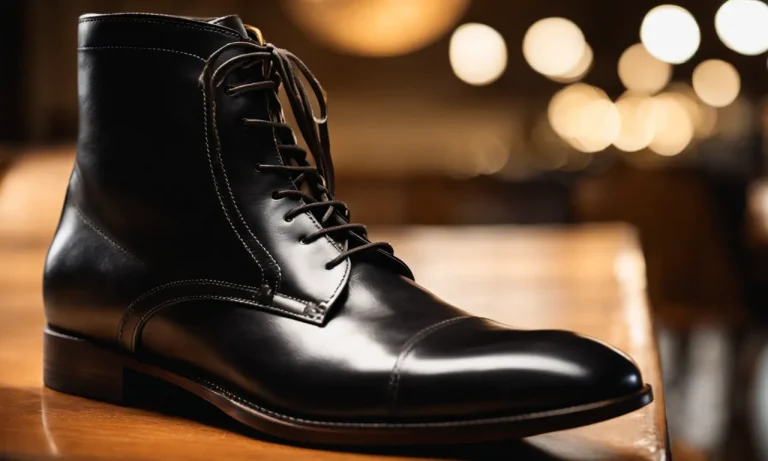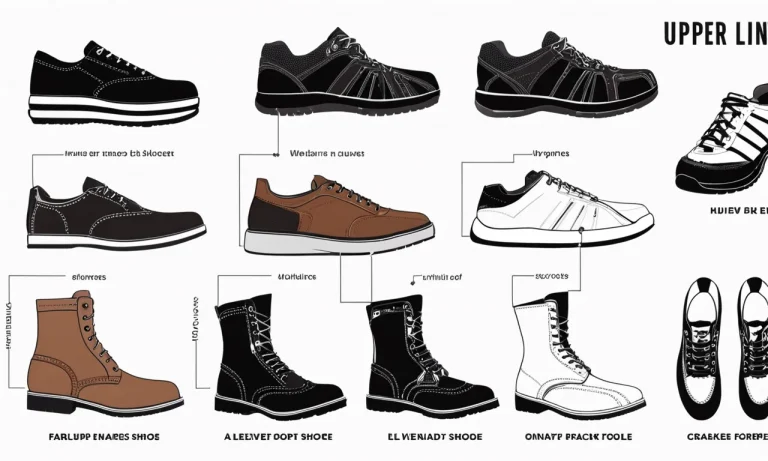Starting a shoe company can be an exciting and rewarding endeavor, but it also requires passion, dedication, and hard work. With the right planning and execution, your dream of having your own shoe brand can become a reality.
If you’re short on time, here’s a quick answer to your question: To start a shoe company, you’ll need to research the market, design unique shoes, source materials and a manufacturer, obtain business licenses and financing, develop a brand identity, and handle sales, marketing and fulfillment.
The key factors for success are creating innovative, quality shoes, building brand awareness, and managing operations efficiently.
In this comprehensive guide, we’ll cover everything you need to know to get your shoe company up and running, step-by-step.
Conduct Thorough Market Research
Before starting a shoe company, it is crucial to conduct thorough market research to gain a deep understanding of the industry, competitors, target customers, and product types and pricing. This research will provide valuable insights that can help guide your business decisions and increase your chances of success.
Analyze industry trends and competitors
One important aspect of market research is analyzing industry trends and studying your competitors. By staying updated on the latest developments and trends in the shoe industry, you can identify new opportunities and potential gaps in the market.
Additionally, studying your competitors can help you understand their strengths and weaknesses, allowing you to position your shoe company uniquely.
Make use of industry reports, trade publications, and online resources to gather information about the overall market size, growth rate, and any emerging trends. Look into the strategies and marketing techniques used by successful shoe companies to gain insights and inspiration for your own business.
Identify your target customer
Understanding your target customer is essential for the success of your shoe company. Identify the specific demographics, preferences, and lifestyles of your potential customers. Consider factors such as age, gender, location, income level, and fashion preferences.
Conduct surveys, interviews, or focus groups to gather direct feedback from your target audience. This will help you gain insights into their needs, desires, and pain points. By understanding your target customers, you can develop products that cater to their specific preferences and create effective marketing campaigns to reach them.
Determine product types and pricing
Another crucial aspect of market research is determining the types of shoes you will offer and setting appropriate pricing. Analyze the current market offerings and identify any gaps or unmet needs. Consider factors such as style, functionality, comfort, and durability when deciding on the types of shoes to produce.
When setting the pricing for your shoes, consider factors such as production costs, competitors’ pricing, and perceived value. Conducting a thorough analysis of the market will help you set prices that are competitive yet profitable for your shoe company.
Remember, market research is an ongoing process. Continuously monitor industry trends, customer preferences, and competitor strategies to stay ahead of the game and make informed business decisions.
For more information and resources on market research, you can visit websites like MarketResearch.com or Statista.com.
Design Your Shoes
Designing your shoes is an exciting and crucial step in starting your own shoe company. The design process allows you to unleash your creativity and create unique and appealing footwear that will capture the attention of your target market. Here are three key steps to help you design your shoes:
Decide on styles and materials
Before diving into the design process, it’s essential to decide on the styles and materials you want to incorporate into your shoe collection. Consider the current fashion trends, market demand, and your target audience’s preferences.
Researching popular shoe styles and materials can provide valuable insights into what customers are looking for. Websites like Vogue or Elle can be great sources of inspiration for your design choices.
Create prototypes and samples
Once you have a clear vision of your shoe designs, it’s time to bring them to life through prototypes and samples. This step involves working closely with manufacturers or skilled artisans who can transform your design ideas into tangible products.
Collaborating with professionals who have expertise in shoe production can help you ensure that your designs are executed accurately. Consider seeking assistance from organizations like the Footwear Distributors and Retailers of America (FDRA) or local shoe manufacturing associations to connect with reliable manufacturers.
Refine designs based on feedback
Feedback is crucial for improving your shoe designs and making them more marketable. Seek opinions from potential customers, industry experts, and even friends and family. Consider conducting focus groups or surveys to gather valuable insights on your designs’ appeal, comfort, and overall quality.
Use this feedback to make necessary adjustments and refinements to your shoe designs. Remember, the goal is to create shoes that not only look great but also provide comfort and durability.
By following these steps, you can ensure that your shoe designs are well thought out and meet the expectations of your target market. Remember, the design process is an ongoing journey, and it’s important to stay open to feedback and continuously refine your designs to stay ahead in the competitive shoe industry.
Source Materials and Manufacturing
When starting a shoe company, one of the most crucial aspects is sourcing the right materials and finding reliable manufacturing partners. Here are some essential steps to consider:
Research and choose material suppliers
The quality of your shoes depends on the materials you use. It’s important to research and choose reputable material suppliers that offer high-quality materials for your shoe production. Look for suppliers who specialize in shoe materials and have a track record of providing excellent products.
Some popular material suppliers include XYZ Suppliers and ABC Footwear Materials.
Consider factors such as the durability, comfort, and aesthetic appeal of the materials when making your selection. It’s also important to consider the cost and availability of the materials. Conduct thorough research and compare different suppliers to find the best fit for your shoe company.
Find and vet manufacturing partners
Finding a reliable manufacturing partner is crucial for the success of your shoe company. Look for manufacturers who have experience in producing shoes and have a good reputation in the industry. You can start by searching for manufacturing companies that specialize in footwear production.
When vetting potential manufacturing partners, consider factors such as their production capacity, quality control processes, and their ability to meet deadlines. It’s also important to visit their facilities or request samples to ensure that their production standards align with your expectations.
Additionally, consider working with manufacturers who have ethical and sustainable practices. Consumers are increasingly conscious of the environmental impact of their purchases, so partnering with manufacturers who prioritize sustainability can give your shoe company a competitive edge.
Negotiate payment terms and minimum orders
Once you have identified potential material suppliers and manufacturing partners, it’s time to negotiate the terms of your partnership. Discuss payment terms, such as the amount and frequency of payments, to ensure they align with your financial capabilities.
Additionally, inquire about the minimum order quantities (MOQ) required by the suppliers and manufacturers. MOQ refers to the minimum number of shoes or materials you need to order in each production run. Negotiate the MOQ to ensure it is feasible for your company’s initial production needs.
Keep in mind that some suppliers and manufacturers may offer better pricing and terms for larger orders. Consider your projected sales and growth plans when deciding on the order quantities and negotiating with your partners.
Remember, sourcing the right materials and finding reliable manufacturing partners are crucial steps in starting a successful shoe company. Take the time to research, vet, and negotiate to ensure that you are working with the best suppliers and manufacturers for your specific needs.
Handle Legal and Financial Requirements
Starting a shoe company involves handling various legal and financial requirements. It is important to ensure that you have all the necessary paperwork in order to operate your business legally and protect yourself from potential liabilities.
Choose a business structure
Before you can register your shoe company, you need to decide on the right business structure. The most common options for small businesses include sole proprietorship, partnership, limited liability company (LLC), and corporation.
Each structure has its own advantages and disadvantages, so it’s important to consult with a legal professional or accountant to determine which one is best for you.
Register your business
Once you have chosen a business structure, you will need to register your shoe company with the appropriate government authorities. This typically involves filing the necessary paperwork and paying any required fees.
The specific requirements vary depending on your location, so be sure to research the regulations in your area or consult with a business attorney to ensure compliance.
Open a business bank account
Separating your personal finances from your business finances is essential for proper accounting and legal protection. Opening a business bank account allows you to keep track of your income and expenses, accept payments from customers, and make business-related transactions.
Look for a bank that offers business banking services and compare the fees and features to find the best fit for your shoe company’s needs.
Obtain financing and insurance
Starting a shoe company requires capital to fund your operations. Depending on your financial situation, you may need to seek financing from banks, investors, or other sources. Conduct thorough research to find the best financing options available to you.
Additionally, it’s crucial to protect your business with proper insurance coverage. Speak with an insurance agent who specializes in business insurance to determine the types of coverage you need to safeguard your shoe company from potential risks.
Build Your Brand Identity
When starting a shoe company, building a strong brand identity is essential for success. A well-defined brand helps differentiate your company from competitors and creates a unique identity that resonates with your target audience.
Here are some important steps to take when building your brand identity:
Name your company and design a logo
The first step in building your brand identity is to come up with a catchy and memorable name for your shoe company. Consider a name that reflects the values and personality of your brand. Once you have a name, design a logo that visually represents your brand.
Your logo should be simple, versatile, and easily recognizable.
Create branded assets like labels, packaging, etc.
Branded assets such as labels, packaging, and other materials are important for creating a cohesive and professional brand image. Design labels that can be attached to your shoes, showcasing your brand logo and name. Create packaging that reflects the quality and style of your shoes.
Additionally, consider creating other branded assets like business cards, letterheads, and promotional materials.
Craft your brand story and messaging
A compelling brand story helps connect with customers on an emotional level and build brand loyalty. Craft a brand story that explains the inspiration behind your shoe company, your mission, and what sets your brand apart.
Develop messaging that communicates the unique selling points of your shoes, such as their comfort, durability, or eco-friendly materials. Ensure that your brand messaging is consistent across all platforms and channels, including your website, social media, and marketing materials.
Building a strong brand identity takes time and effort, but it is crucial for the long-term success of your shoe company. By carefully considering your company name, designing a memorable logo, creating branded assets, and crafting a compelling brand story, you can establish a unique and recognizable brand that resonates with your target audience.
Market and Sell Your Products
Once you have developed your unique line of shoes, it’s time to focus on marketing and selling your products. This is a crucial step in establishing your brand presence and generating sales. Here are some key strategies to consider:
Develop marketing strategy and assets
Creating a comprehensive marketing strategy is essential for reaching your target audience and promoting your shoe brand. Start by identifying your target market and understanding their preferences, needs, and purchasing behavior.
This will help you tailor your marketing efforts to effectively reach and engage with your potential customers.
Invest in creating high-quality marketing assets such as professional product photography, compelling product descriptions, and engaging social media content. These assets will form the foundation of your marketing campaigns and help showcase the unique features and benefits of your shoes.
Build an ecommerce site
Having a well-designed and user-friendly ecommerce website is crucial for selling your shoes online. Choose a reliable ecommerce platform that offers features such as secure payment gateways, easy navigation, and mobile responsiveness.
Ensure that your website reflects your brand identity and provides a seamless shopping experience for your customers.
Optimize your website for search engines by incorporating relevant keywords in your product descriptions and meta tags. This will help improve your website’s visibility and organic traffic, leading to increased sales.
Establish sales channels like retailers
While having your own ecommerce site is important, don’t overlook the potential of partnering with retailers to expand your reach. Research and approach potential retailers who align with your brand values and target market.
Building relationships with retailers can help you tap into their existing customer base and gain credibility in the industry.
Consider attending trade shows and industry events to showcase your shoes to potential retailers and connect with key industry players. Networking and building partnerships in the industry can open doors for collaborations and distribution opportunities.
Manage order fulfillment and inventory
Efficiently managing order fulfillment and inventory is crucial for customer satisfaction and maintaining a smooth operation. Consider partnering with a reliable fulfillment center that can handle packaging, shipping, and returns on your behalf.
This will free up your time to focus on other aspects of running your shoe company.
Implement inventory management software to keep track of your stock levels, monitor product performance, and forecast future demand. This will help you avoid stockouts or overstocking, ensuring that you always have the right amount of inventory to meet customer demand.
By implementing these strategies, you can effectively market and sell your shoe products, reaching a wider audience and maximizing your sales potential. Remember, building a successful shoe company takes time and effort, so stay dedicated and adaptable to the ever-evolving market trends.
Conclusion
Launching a successful shoe company takes significant time, effort, and resources. But with dedication to designing quality shoes, building a strong brand, and running a lean operation, your startup can gain a foothold in the market.
Remember to thoroughly research the industry, create differentiated products, secure reliable manufacturing, and implement targeted marketing. With a strategic, step-by-step approach, your dream of having your own shoe brand can become a reality.






